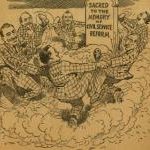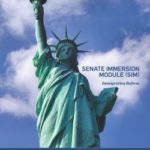This short comparative analysis activity involves comparing and contrasting two images of marches for freedom: a 1917 Bastille Day march for women’s suffrage, and the 1963 March on Washington for Jobs and Freedom. Students will consider the similarities and differences between these two images and hypothesize what major differences these photos might imply about the two social reform movements.
Civic Conversations
How do educators invest in productive, deep, and transformative dialogue in their classrooms? Civic Conversations is a collaboration between the Edward M. Kennedy Institute’s civic education programming and the community-building dialogic structure practiced by Essential Partners. Explore resources, activities, and lesson structures that support educators as they facilitate difficult conversations, create inclusive learning environments, raise complex discussions, and promote a safe space for students to consider their values and engage in their communities. Policy simulations at the Kennedy Institute reflect the wide range of issues that face our country today. Students debate the best way to reform our immigration system, consider the balance between privacy and security, and think about how to meet the challenge of climate change. As in the real Senate, it’s natural that students will disagree on the best approach to many civic issues. This collection of resources will support educators as they prepare to discuss civic issues, either in preparation for a Kennedy Institute field trip or to practice listening, sharing, and learning in the classroom.
19th Amendment: Women’s Right to Vote
In this learning module, students will trace the roots of the women’s rights movement, from early reform efforts in the 1800s to the ultimate decision to pursue voting rights. This unit explores the constitutional arguments over women’s suffrage, the historical context of the fight for suffrage over 70 years, and the tactics suffragists used to persuade state legislatures and the national government to recognize voting rights for women.
Civil Service Reform: Creating a Merit System for Pennsylvania

The Gilded Age of the late 19th century is not typically recalled as an age of reform. Characterized by industrialization, urbanization, and rapid population growth, it was an era of remarkable economic expansion. The Gilded Age also saw a dramatic expansion in the size and scope of government—the federal government employed just 53,000 people in 1871, but numbered 256,00 employees by 1900. Patronage politics was the norm, at every level of government.
FEC v. Wisconsin Right to Life (2007)
Can the Bipartisan Campaign Reform Act restrict issue ads from airing months before an election? This case summary shows how the Supreme Court answered that question in 2007.
The Constitutional Convention: Reform or Revolution?
History is the chronicle of choices made by actors/agents/protagonists in specific contexts. This simulation places students at the opening of the Constitutional Convention and asks them to deliberate on the overarching question delegates faced at that moment: Should they propose alterations to the Articles of Confederation, or should they construct an entirely different plan that would supplant the Articles? By engaging with this momentous issue, students will understand the enormity of the “revolution in favor of government” that occurred in 1787.
Immigration Reform (SIM Lesson Plans)

The purpose of this learning module is to help students learn how a U.S. Senator might address an issue of public significance under consideration in the United States Congress. Learning about personal, state, party, and national interests will help students understand representation more fully. The pre-visit examines how elected representation works. The post-visit lesson supports critical analysis of each student’s strategic choices and votes, preparing them to defend their efforts.
Citizens United v. FEC (2010)
Does a law that limits the ability of corporations and labor unions to spend their own money to advocate the election or defeat of a candidate violate the First Amendment’s guarantee of free speech? The Supreme Court has held that donations and campaign spending are forms of speech.
Williams-Yulee v. Florida Bar (2015)
Does a law that prohibits candidates for judicial office from personally asking for campaign funds violate the First Amendment? This case summary looks at First Amendment protections against Florida Bar Association regulations.
Choosing to Make a Nation: Constitutional Convention Simulation
The Choosing to Make a Nation Curriculum Project developed by award-winning author Ray Raphael is a student-centered, primary source-rich approach to teaching about American history and our nation‘s founding documents.
An 8-lesson simulation in which students become delegates from specific states and address the same issues the framers faced. Unit includes the following lesson plans –
(1) Reform or Revolution?
(2) Composition of Congress
(3) Creating an Executive Branch
(4) Should Judges Judge Laws?
(5) Balance of Powers
(6) Slavery and the Constitution
(7) Amendments and Ratification
(8) To Sign or Not to Sign?
Option A: The historical Constitution
Option B: Student-generated constitution